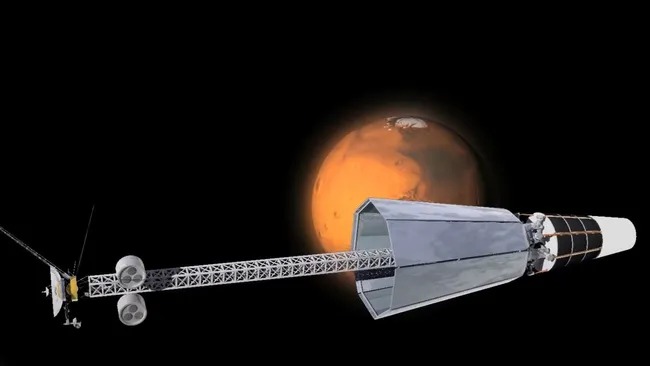
For the first time since 1965, the US military is gearing up to launch a nuclear reactor into space.
In space exploration, using fission power for a nuclear reactor makes a lot of sense. Nuclear thermal propulsion (NTP) engines, like the ones Lockheed Martin is developing for DARPA’s DRACO program, offer greater efficiency, shorter travel times, and the ability to carry larger loads for missions in the area, known as cislunar operations, between Earth and the Moon.
However, fission power isn’t limited to just making spacecraft go. It has broader applications, and that’s why the U.S. military is investing a substantial $33.7 million in Lockheed Martin, along with Space Nuclear Power Corp (SpaceNukes) and BWX Technologies, Inc. (BWXT).
The goal is to kickstart the design of a nuclear-powered spacecraft as part of the Joint Emergent Technology Supplying On-Orbit Nuclear (JETSON) project.
Nuclear fission to fuel Stirling engines
In a groundbreaking move, a technology demonstrator will be using nuclear fission to fuel Stirling engines. These engines are expected to generate significant electricity, ranging from six to twenty kilowatts electric (kWe). Lockheed Martin asserts that this approach delivers four times the power compared to traditional solar arrays, all without relying on constant sunlight.
This innovative technique draws inspiration from NASA’s Kilopower Reactor Using Stirling Technology (KRUSTY) experiment. KRUSTY aimed to explore ways of harnessing nuclear power to supply electricity for future Moon outposts and, eventually, Mars missions.
Barry Miles, the JETSON program manager and principal investigator at Lockheed Martin, emphasized the pivotal role of nuclear fission development in space applications. He stated, “Nuclear fission development for space applications is key to introducing technologies that could dramatically change how we move and explore in the vastness of space.”
Activation of the fission engine
The fission engine is designed to remain inactive during launch and only activates when the JETSON spacecraft reaches a secure, non-decaying Earth orbit. Once the fission reactor generates energy, it will be utilized to power Hall-effect thrusters.
These thrusters, a type of ion thruster electrified to create acceleration, are already in use on Lockheed Martin’s LM2100 satellites. Fission supplies the necessary electricity for acceleration and serves as the energy source for onboard systems and payloads, making it a comprehensive solution for all the spacecraft’s energy requirements.
Launching of nuclear reactor into space
For the first time since 1965, the United States military is preparing to launch its first nuclear reactor into space. The last instance was with the SNAP-10A experimental nuclear-powered satellite, which also marked the debut of ion thrusters in space.
Breaking News: Lockheed Martin Secures $33.7 Million Contract from US Military to Advance Nuclear Spacecraft Technologies 🛰️
Lockheed Martin, the aerospace giant, has been awarded a $33.7 million contract by the U.S.
(Image credit: LANL) pic.twitter.com/WiqR0CMmJ3
— Cosmo Porn (@cosmo_porn) November 14, 2023
Lockheed Martin asserts that the upcoming spacecraft, currently undergoing a preliminary design review, will enhance maneuver and power capabilities, shaping future space force operations.
In addition to Lockheed Martin’s efforts, Intuitive Machines in Houston has secured $9.4 million to develop a spacecraft using a compact radioisotope power system.
Meanwhile, Westinghouse Government Services in South Carolina has received funding to explore high-power fission systems for future spacecraft. While the role of fission on Earth can be complex, its application in space technology is increasingly seen as an obvious choice.
See all the latest news from Greece and the world at Greekreporter.com. Contact our newsroom to report an update or send your story, photos and videos. Follow GR on Google News and subscribe here to our daily email!



